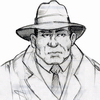I'm wondering how you guys resharpen your chisels and handplane blades. I always put a microbevel on my blades and when they get dull, I only resharpen the microbevel and then remove the burr on the back. I'm thinking that at some point I'm gonna have to resharpen the primary bevel no ? How often should one completely resharpen the whole thing ? My understanding is that each time I redo the microbevel, it ends up getting bigger and bigger




 Reply With Quote
Reply With Quote






